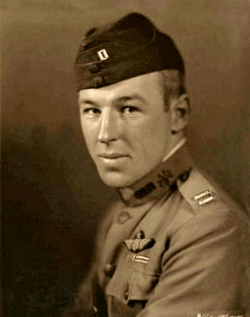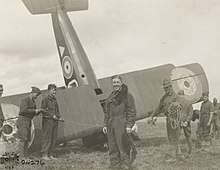Elliott White Springs
Elliott White Springs (July 31, 1896 – October 15, 1959), was a South Carolina businessman and an American flying ace of World War I, credited with shooting down 16 enemy aircraft.[1]
Elliott White Springs | |
|---|---|
 Elliott White Springs, 1918 | |
| Born | July 31, 1896 Lancaster, South Carolina |
| Died | August 15, 1959 (aged 63) Memorial Hospital, New York City, New York |
| Buried | Unity Cemetery, Fort Mill, South Carolina, USA |
| Allegiance | |
| Service/ | Royal Air Force (United Kingdom) Air Service, United States Army |
| Rank | Captain |
| Unit | Royal Air Force
Air Service, United States Army |
| Battles/wars | World War I World War II |
Early life
Springs was born to Col. Leroy Springs and Grace Allison White Springs. His father was a noted South Carolina textiles manufacturer. Springs attended Culver Military Academy, and then Princeton University.[1]
World War I service

Springs enlisted in the United States Army in the autumn of 1917. He was sent to England to train with the [Royal Flying Corps], and was selected by the Canadian flying ace Billy Bishop to fly the S.E.5 with 85 Squadron over France. After claiming three destroyed and one 'out of control' with 85 Squadron, Springs was shot down on 27 June 1918 by Lt. Josef Raesch of Jasta 43. After recovering from wounds received, he was reassigned to the U.S. Air Service's 148th Aero Squadron, flying the Sopwith Camel[1]
On 3 August 1918, while escorting Airco DH.9 bombers, Springs shot down three Fokker D.VII scouts in flames. On 22 August 1918 he attacked five Fokker DVIIs, shooting down one into a wood near Velu. He sent another enemy aircraft 'out of control'. On 22 August 1918 he engaged three Fokker DVIIs, and Springs claimed two shot down, with one 'out of control'.
By 24 September 1918 Springs had claimed 10 victories destroyed, 2 shared destroyed and 4 driven down 'out of control'. He had shared three wins with such squadron mates as Lieutenants Henry Clay and Orville Ralston.[1][2] Also about this time Springs rose to command the 148th as it and the 17th Aero Squadron joined the 4th Pursuit Group.[1]
Return to civilian life
Upon his return to the United States, Springs wrote numerous books, short stories, and articles. Many of these were about his experiences in combat aviation. The most notable of these was Warbirds: The Diary of an Unknown Aviator, which was based the correspondence of John McGavock Grider, a friend and comrade of his who did not survive the war.[1] He was also known for carousing, habits he picked up overseas in the War. He toured speakeasies, drank heavily, chased women, and hosted all-night parties. He regularly visited friends "with a five-gallon jug and a strange woman."
He also did some barnstorming after his return.[1] On November 11, 1953, he appeared on an episode of I've Got a Secret
Management of Springs Cotton Mills
Springs profligate life changed in 1931 when his father died and he took over running the family textile firm.
Though the firm was heavily mortgaged, Springs saved the company though, among other things, slashing his own salary. Springs even put a loom in his basement to try out new ideas. Because of his actions, the family firm made it through the Great Depression that saw many of his competitors close.
Return to service
In 1941, Springs returned to his nation's service in the U.S. Army Air Corps.[1]
Later years and death
Springs continued to run Springs Cotton Mills until shortly before his death. He died of pancreatic cancer.[3]
His home, known as the William Elliott White House, was added to the National Register of Historic Places in 1987.[4][5]
References
- Franks, Norman; Dempsey, Harry (2001). American Aces of World War I. Osprey Publishing. pp. 49–50. ISBN 978-1-84176-375-0.
- "Elliot Springs". TheAerodrome.com. The Aerodrome. Retrieved 2 December 2011.
- Vaughan, David (2012), Letters from a War Bird (1st ed.), Columbia, South Carolina: The University of South Carolina Press
- "National Register Information System". National Register of Historic Places. National Park Service. July 9, 2010.
- "William Elliott White House, York County (N. White St., Ft. Mill vicinity)". National Register Properties in South Carolina. South Carolina Department of Archives and History. Retrieved 2014-07-01.
Bibliography
- Davis, Burke. War Bird: The Life and Times of Elliott White Springs. Chapel Hill: University of North Carolina Press, 1987.
- Letters from a War Bird: The World War I Correspondence of Elliott White Springs. Edited by David K. Vaughan. Columbia, SC: University of South Carolina Press, 2012.
External links
| Wikimedia Commons has media related to Elliott White Springs. |